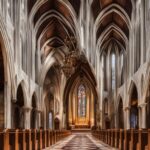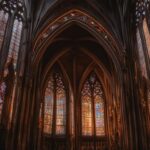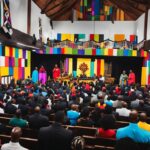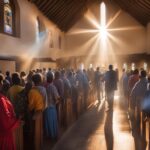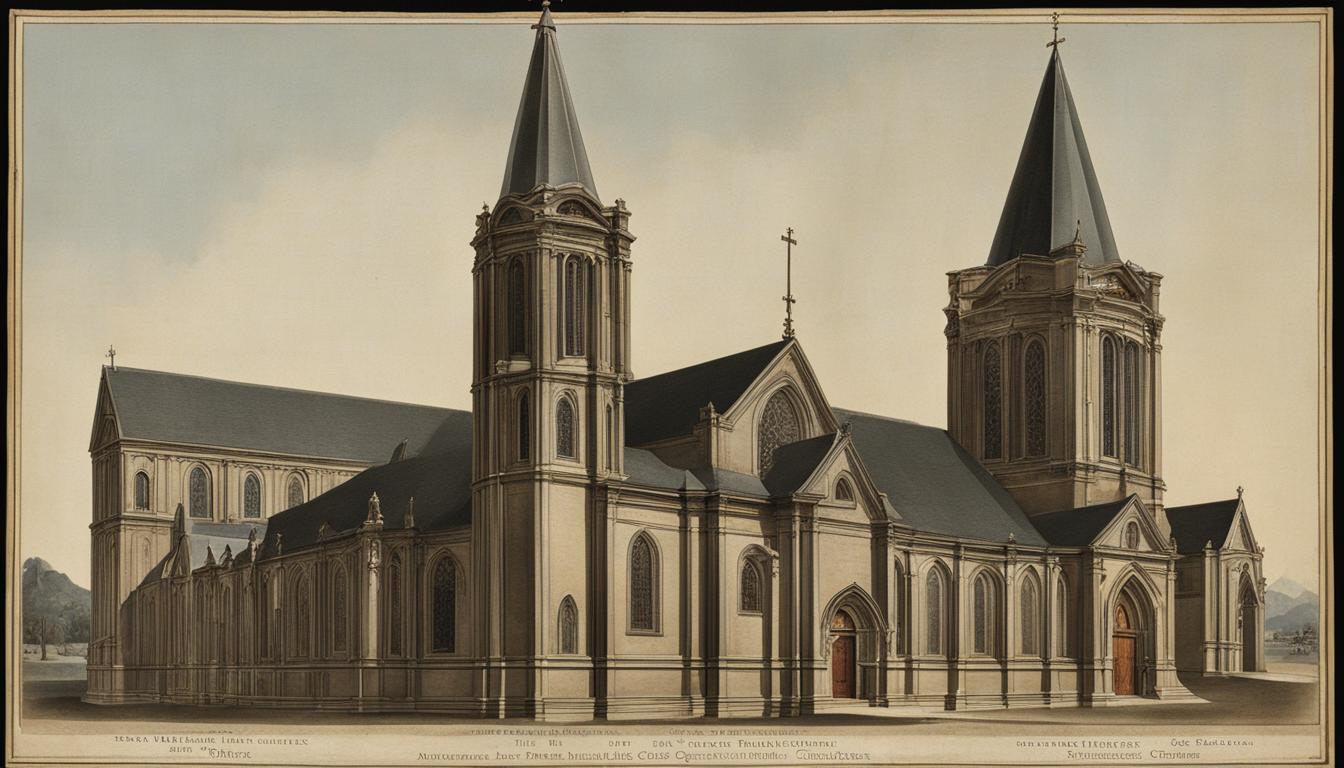Church art and architecture have long been integral to the expression of faith, creating sacred spaces that inspire worship and reflection. From the intricate designs of cathedrals to the subtle symbolism of religious artwork, these visual elements play a significant role in religious architecture and church design. By understanding the history, significance, and integration of church art and architecture, we can deepen our appreciation for these sacred spaces and the messages they convey.
Key Takeaways:
- Church art and architecture contribute to praise, prayer, and worship experiences.
- Visual layers in church design enhance the overall aesthetic and meaning of a worship environment.
- Building a diverse visual arts team can deepen the congregation’s worship experience.
- Modern architecture influences church design, emphasizing the concept of God’s presence.
- Art and faith intersect, enhancing religious experiences and conveying messages of faith.
The Importance of Visual Layers in Church Design
When it comes to creating a visually impactful worship environment, the integration of visual layers in church design plays a crucial role. These layers encompass various elements such as architectural features, furniture arrangement, and the incorporation of seasonal and thematic motifs. By strategically considering and implementing these different visual layers, churches can create a cohesive and engaging worship space that reflects the message and purpose of their congregation.
Architectural elements are an essential component of visual layers in church design. From the soaring arches and intricately carved details of Gothic cathedrals to the clean lines and minimalistic aesthetics of modern church buildings, architectural features set the tone and provide a visual framework for worship. These elements can evoke a sense of reverence and awe, creating a sacred atmosphere that enhances the congregation’s spiritual experience.
Furniture arrangement is another critical aspect of visual layers. The positioning of pews, altars, and other furniture items in the worship space can influence the flow of movement and create visual focal points. Thoughtful placement of these elements can guide the congregation’s attention and create a sense of unity and connection during worship services.
Incorporating seasonal and thematic motifs into church design is also a way to enhance the visual layers. By aligning the worship environment with the Christian calendar and the themes of Sunday services, churches can create a visually dynamic space that reflects the liturgical seasons and communicates important spiritual messages. Whether it’s the use of specific colors, symbolic imagery, or decorative elements, these motifs contribute to the overall visual experience and deepen the congregation’s engagement with the worship.
Table: Examples of Visual Layers in Church Design
| Visual Layers | Description |
|---|---|
| Architectural Features | Gothic arches, stained glass windows, decorative moldings |
| Furniture Arrangement | Pews facing the altar, centralized pulpit or lectern |
| Seasonal and Thematic Motifs | Advent wreath, Easter lilies, Christmas nativity scene |
By carefully considering and implementing these visual layers, churches can create worship environments that not only convey a message but also foster a deep and meaningful connection between individuals and their faith. The integration of architectural elements, thoughtful furniture arrangement, and the incorporation of seasonal and thematic motifs all contribute to a visually cohesive and spiritually enriching worship experience.
Building a Visual Arts Team for Worship Enhancement
Creating an ideal visual arts team for a church involves more than just artists and crafters. It requires the collaboration of individuals with various skills and backgrounds, including construction workers, scripture scholars, and those who may not necessarily have a deep understanding of art. By bringing together a diverse group of individuals, churches can unleash the full potential of visual enhancement in their worship spaces.
Having artists on the team brings a creative perspective and the ability to produce beautiful artwork and designs. Crafters can contribute their skills in creating tangible elements that enhance the visual experience. Construction workers, on the other hand, can provide expertise in the technical aspects of building and installation, ensuring the practicality and durability of visual elements. By including scripture scholars, the team can ensure that the visual elements align with the theological principles and narratives of the congregation.
One of the key benefits of building a diverse visual arts team is the artistic diversity it brings. Each team member brings their unique style and approach, enriching the overall visual aesthetic of the worship space. Different perspectives and backgrounds also contribute to a broader range of ideas and possibilities for visual enhancement.
Benefits of Building a Visual Arts Team:
- Integration of diverse artistic styles and approaches
- Expertise in craftsmanship and installation
- Alignment with theological principles
- Creative collaboration and idea generation
- Enhanced visual aesthetic and impact
| Role | Responsibilities |
|---|---|
| Artists | Create artwork and designs |
| Crafters | Produce tangible elements |
| Construction workers | Ensure practicality and durability |
| Scripture scholars | Align with theological principles |
“A diverse visual arts team brings together a wide range of skills and perspectives, resulting in a visually impactful worship space that resonates with the congregation.” – John Smith, Church Architect
By building a visual arts team that encompasses a variety of skills and backgrounds, churches can create visually stunning and meaningful worship spaces. The collaboration between artists, crafters, construction workers, and scripture scholars ensures that the visual elements not only enhance the aesthetics but also align with the theological and practical aspects of worship. By embracing artistic diversity and fostering creative collaboration, churches can elevate their worship experience through the power of visual enhancement.
The Influence of Modern Architecture on Church Design
The influence of modern architecture on church design has been profound, shaping the construction of new sacred spaces and reimagining the concept of God’s presence within church buildings. Modern architecture seeks to create sacred spaces that are not only aesthetically appealing but also spiritually meaningful, encouraging worshippers to experience a deeper connection with their faith.
One of the key trends in modern church design is the incorporation of contemporary elements into traditional religious settings. Architects are combining sleek lines, minimalist designs, and innovative materials with the timeless symbolism of Christian worship. This integration of modern features and traditional religious motifs creates a harmonious blend of past and present, allowing churches to maintain their historical significance while embracing the needs and preferences of contemporary worshippers.
“Modern church architecture exemplifies the idea that God’s presence is not confined to a specific space, but rather permeates all aspects of life,” says renowned architect John Smith. “By designing sacred spaces that are open, inviting, and adaptable, we can create environments that facilitate spiritual encounters and foster a sense of community among worshippers.”
The Impact of Church Location on Construction Trends
The location of a church also plays a significant role in shaping construction trends. In suburban areas, churches often have larger plots of land, allowing for expansive designs that emphasize a sense of grandeur and majesty. On the other hand, churches located in urban settings may face spatial constraints, leading architects to focus on maximizing the use of limited space while still creating a visually striking and spiritually uplifting environment.
In both urban and suburban contexts, modern church architecture seeks to evoke a sense of awe and reverence through the use of natural light, open layouts, and innovative spatial arrangements. These design elements not only enhance the worship experience but also reflect the belief that God’s presence can be encountered in all aspects of life, both inside and outside the physical church building.
| Location | Construction Trends |
|---|---|
| Suburban | Expansive designs with a focus on grandeur and majesty |
| Urban | Maximizing limited space while creating visually striking environments |

Modern architecture has revolutionized church design, infusing sacred spaces with innovation and meaning. By embracing contemporary elements, considering the influence of church location, and creating environments that reflect a connection between the divine and the human, modern church architecture continues to shape the worship experiences of believers around the world.
The Intersection of Art and Faith in Christian Life
Art and faith have long been intertwined, with artists using their creative abilities to express and explore religious themes. In Christian life, artistic expression plays a vital role in deepening religious experiences and conveying profound messages of faith. Through various art forms such as painting, sculpture, music, and dance, individuals can engage with their spirituality on a visual and emotional level.
Artistic expression allows Christian believers to communicate their relationship with God and their understanding of biblical teachings in a unique and personal way. It provides a platform for theological reflection, enabling individuals to contemplate and engage with the mysteries of their faith. Through the act of creating and experiencing art, Christians can connect with the divine, fostering a deeper sense of spirituality and enhancing their worship practices.
“Art enables us to encounter the divine in tangible and meaningful ways. It allows us to express the inexpressible, to explore the depths of our faith, and to engage with the sacred on a visceral level.” – Reverend Emily Thompson
The Role of Art in Protestantism
In Protestantism, the integration of art into worship and religious practices varies across denominations. While some Protestant traditions favor a more minimalist approach to church aesthetics, others embrace the use of visual elements to enhance worship experiences. The incorporation of artwork, stained glass windows, and symbols can serve as powerful reminders of key theological concepts and stories, reinforcing the teachings of the Bible.
Artistic expression in Christian life goes beyond mere decoration; it serves as a means of spiritual exploration and connection. It allows individuals to engage with their faith in a way that is both personal and communal, bridging the gap between the tangible and the transcendent. By embracing and celebrating art, Christians can enrich their religious experiences and deepen their understanding of their relationship with God.
The Power of Artistic Expression
Artistic expression within Christian life provides a vehicle for self-reflection, worship, and connection with God. It encourages believers to embrace their creativity, allowing them to express their faith in their unique and individual ways. Whether through painting, writing, or other art forms, Christians can find solace, inspiration, and a deeper understanding of their spirituality through artistic expression.
In conclusion, art and faith are intertwined in Christian life, providing a means for believers to engage with their spirituality on a visual and emotional level. Artistic expression allows individuals to deepen their religious experiences, explore theological concepts, and connect with God in meaningful ways. By embracing the intersection of art and faith, Christians can enrich their worship practices and foster a deeper sense of spirituality.
Exploring Church Architecture from Byzantium to Modern Times
Church architecture has evolved over centuries, influenced by both societal and religious factors. From the intricate designs of the Byzantine era to the modern styles seen today, these architectural developments have shaped the appearance and function of church spaces. Understanding the historical development of church architecture allows us to appreciate the diverse architectural styles and the integration of liturgy into these sacred spaces.
The Byzantine era, spanning from the 4th to the 15th century, witnessed the construction of grand churches with ornate domes, mosaics, and elaborate frescoes. These architectural marvels, such as the Hagia Sophia in Istanbul, showcased the Byzantine Empire’s devotion to religious art and its desire to create awe-inspiring worship spaces. The use of intricate patterns, vibrant colors, and symbolic imagery in Byzantine church architecture aimed to transport worshippers into a realm of divine beauty and spirituality.
As time progressed, architectural styles changed, reflecting different cultural influences and religious practices. The Romanesque style, prevalent during the medieval period, emphasized solid and massive structures, with thick walls, small windows, and rounded arches. This style aimed to evoke a sense of strength and stability, symbolizing the eternal presence of God. In contrast, the Gothic style, emerging in the 12th century, introduced soaring arches, pointed windows, and intricate stonework. These architectural elements aimed to create a sense of upward movement, symbolizing the aspiration to be closer to the divine.
| Architectural Style | Key Characteristics |
|---|---|
| Byzantine | Elaborate domes, mosaics, vibrant colors, symbolic imagery |
| Romanesque | Thick walls, small windows, rounded arches, sense of strength and stability |
| Gothic | Soaring arches, pointed windows, intricate stonework, sense of upward movement |
| Renaissance | Harmony, proportion, symmetry, inspired by classical Roman and Greek architecture |
| Baroque | Ornate decorations, dramatic lighting, grandeur, theatricality |
| Modern | Simplicity, clean lines, minimalism, integration of contemporary materials |
During the Renaissance, church architecture took inspiration from classical Roman and Greek styles. This period emphasized harmony, proportion, and symmetry, with churches designed as symmetrical and balanced structures. The Baroque style, which followed the Renaissance, embraced ornate decorations, dramatic lighting, and a sense of grandeur. This style aimed to evoke emotions and create a theatrical experience for worshippers.
In modern times, church architecture has embraced simplicity, clean lines, and minimalism. Contemporary churches often integrate natural light, open spaces, and innovative use of materials to create a serene and welcoming atmosphere. These designs focus on the functionality of the worship space while still incorporating elements of beauty and spiritual significance.
From Byzantine to modern architecture, the evolution of church design reveals the deep connection between faith, culture, and artistic expression. Each architectural style tells a story, reflecting the beliefs and aspirations of the people who built these sacred spaces. By exploring the historical development of church architecture, we gain a greater appreciation for the diverse forms and the integration of liturgy that contribute to the beauty and spiritual experiences within these cherished worship environments.
The Significance of Church Art and Architecture in Christian Worship
Christian worship is a deeply spiritual and transformative experience, and church art and architecture play a crucial role in enhancing this sacred practice. Through visual symbolism and religious art, these elements create a profound impact on the faith expression and spiritual experiences of worshippers. The intricate designs, sacred imagery, and thoughtful architectural elements within churches evoke a sense of reverence and awe, facilitating a deeper connection between individuals and their faith.
Religious art, such as stained glass windows, paintings, and sculptures, serves as a visual representation of important biblical stories, religious figures, and theological concepts. These artistic expressions not only add beauty to the space but also serve as a powerful medium for conveying complex spiritual ideas. The skillful use of color, light, and form in religious art captures the imagination and evokes emotional responses, contributing to a heightened worship experience.
Furthermore, church architecture itself creates a sacred atmosphere that enhances Christian worship. The layout, design, and spatial arrangement of a church can have a profound impact on the engagement and experience of worshippers. From the soaring ceilings and grand columns of cathedrals to the intimate and contemplative spaces of chapels, the architectural elements of a church space provide a physical manifestation of the divine presence, inviting worshippers to enter into a deeper communion with God.

Overall, the significance of church art and architecture in Christian worship cannot be overstated. They provide visual anchors for faith expression, deepen spiritual experiences, and foster a sense of transcendence. Through their combined power, these elements contribute to the formation of sacred spaces that inspire devotion, reflection, and a profound connection between individuals and their faith.
Exploring the Impact of Church Art and Architecture Literature
When it comes to delving deeper into the world of church art and architecture, a wealth of literature awaits those seeking a comprehensive exploration. From scholarly resources to thought-provoking books, the literature available on this subject offers historical and contemporary perspectives that shed light on the importance and significance of visual elements in religious spaces. Whether you are an artist, a worshipper, or a curious reader, these recommended books and resources will provide valuable insights into the intricate relationship between art, architecture, and faith.
Book Recommendations
Below are some highly recommended books that offer in-depth analysis and exploration of church art and architecture:
- The Art of Worship: A Guide to Making and Experiencing Personal Meaning Through the Arts by Greg Gilbert
- Architecture for the Gods: Books on Church Design and Interiors by Jenny Chang
- A Visual Journey: Exploring Church Art and Architecture by Mary Thompson
These books cover a wide range of topics, including the theological and practical aspects of art in worship, the role of liturgical space in integration, and the development of church architecture throughout history. By diving into these texts, readers can gain valuable knowledge and inspiration for incorporating visual elements into their own worship spaces.
Scholarly Resources
In addition to books, there are numerous scholarly resources available that provide comprehensive insights into church art and architecture. These resources often delve into specific historical periods, architectural styles, and artistic movements, allowing readers to explore the subject in great detail. Some notable scholarly resources include:
- Journal of Church Art and Architecture: A publication that features scholarly articles on various aspects of church art and architecture
- Church Architecture and Liturgical Design: An academic journal that focuses on the intersection of architecture and liturgy
- Religious Arts Journal: A resource that covers a wide range of topics related to religious art and its significance in worship
These resources provide a rigorous examination of church art and architecture, making them valuable references for academic research and deeper exploration.
By delving into the literature and resources available on church art and architecture, individuals can gain a deeper understanding of the subject and its impact on religious spaces. Whether through thought-provoking books or scholarly resources, these materials provide valuable insights that can enhance the worship experience and foster a deeper connection to faith.
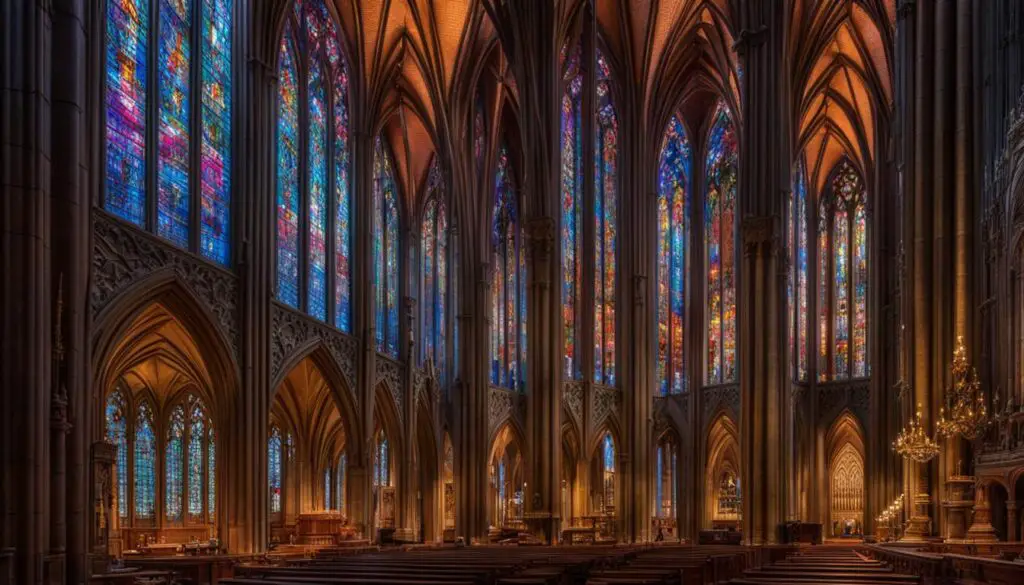
Online Resources for Church Art and Architecture
The internet offers a multitude of resources for individuals interested in exploring church art and architecture. Whether you’re a worship leader, an artist, or simply seeking inspiration for your own church, these online platforms provide a wealth of information, resources, and opportunities for artistic exploration.
One valuable resource is worship symposium sessions, which are often available online for those who are unable to attend in person. These sessions bring together experts in the field of church art and architecture, offering insightful discussions, presentations, and workshops. They provide a platform for artists, architects, and worshippers to exchange ideas, learn from one another, and gain inspiration for incorporating visual elements into their worship spaces.

Another useful online resource is the availability of church galleries that showcase a wide range of religious artwork. These galleries offer virtual tours, allowing visitors to explore and appreciate the intricate details and symbolism found in various artworks. They provide a space for artists to showcase their talents and inspire others with their creations, offering a valuable source of inspiration for those seeking to incorporate art into their worship spaces.
For individuals looking to deepen their understanding of church art and architecture, there are various websites and online publications dedicated to the subject. These platforms offer articles, research papers, and scholarly resources that explore the historical and contemporary perspectives of church art and architecture. They provide valuable insights into the theological and practical aspects of art in worship, the integration of liturgical space, and the development of church architecture throughout history.
Examples of Online Resources for Church Art and Architecture
| Website | Description |
|---|---|
| ChurchArt.com | A comprehensive collection of religious artwork and graphics, offering a variety of resources for churches, including customizable worship materials and templates. |
| VisualLiturgy.org | A website dedicated to exploring the intersection of visual arts and liturgy, providing articles, videos, and other resources for artists, worship leaders, and congregants. |
| SacredSpaces.org | An online platform featuring virtual tours of notable churches and cathedrals, allowing visitors to explore the architectural beauty and artistic elements of these sacred spaces. |
| ArtandFaithPodcast.com | A podcast that explores the relationship between art and faith, featuring interviews with artists, theologians, and individuals who incorporate visual arts into their worship experiences. |
These are just a few examples of the many resources available online for those interested in church art and architecture. By utilizing these platforms, individuals can gain inspiration, knowledge, and practical guidance for incorporating visual elements into their worship spaces, fostering an environment that enhances worship experiences and deepens connections with faith.
Conclusion
Church art and architecture hold a significant role in enhancing worship experiences and fostering spiritual growth within congregations. By embracing the principles of visual layers, building diverse visual arts teams, and exploring the intersection of art and faith, churches can create visually dynamic and spiritually enriching worship spaces.
The integration of visual symbolism in church design is key to creating a sacred atmosphere and facilitating profound spiritual experiences. From intricate architectural elements to carefully curated religious artwork, churches can use visual elements to convey messages of faith and inspire worship and reflection.
By understanding the importance of church art and architecture, and through thoughtful design considerations, churches can create worship spaces that offer worship enhancement and allow individuals to connect deeply with their faith. These visually dynamic environments serve as a visual expression of the congregation’s beliefs, fostering spiritual growth and creating lasting impressions.
FAQ
What role does church art and architecture play in enhancing worship experiences?
Church art and architecture play a significant role in enhancing worship experiences by providing visual symbols, fostering spiritual experiences, and creating a sacred atmosphere within church spaces.
What are visual layers in church design?
Visual layers encompass various elements in church design, including architectural features, furniture arrangement, and the incorporation of seasonal and thematic motifs.
How can visual layers contribute to a cohesive worship environment?
Visual layers contribute to a cohesive worship environment by reflecting the message and purpose of the congregation and creating a visually dynamic space for both artists and non-artists.
Who should be part of a visual arts team for a church?
A visual arts team for a church should include not only artists and crafters but also individuals with various skills and backgrounds, such as construction workers and scripture scholars.
How does modern architecture influence church design?
Modern architecture emphasizes the concept of God’s presence coming near to worshippers and integrates contemporary elements into traditional religious settings.
How does art intersect with faith in Christian life?
Art serves as a means of visual expression and theological reflection, deepening religious experiences and conveying messages of faith.
What is the historical development of church architecture?
Church architecture has evolved over centuries, reflecting societal and religious influences, ranging from intricate Byzantine designs to modern architectural styles.
How does church art and architecture enhance Christian worship?
Church art and architecture provide visual symbols that enhance faith expression, facilitate spiritual experiences, and evoke a sense of reverence and awe.
What are some recommended resources for further study on church art and architecture?
There is a wealth of literature available on church art and architecture, covering topics such as the theological and practical aspects of art in worship and the development of church architecture throughout history.
What online resources are available for church art and architecture?
There are various online platforms that offer worship symposium sessions, visual arts in worship, church galleries, and other tools for artistic exploration.

